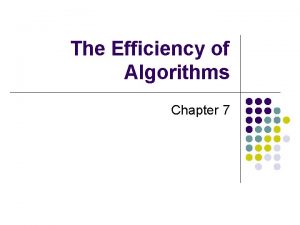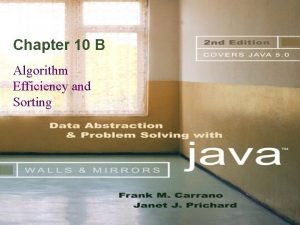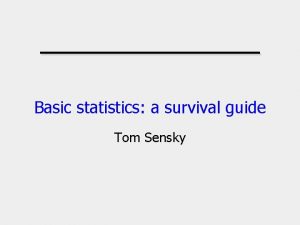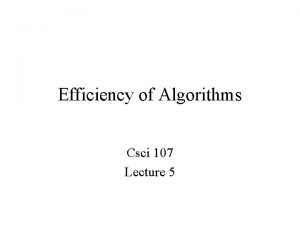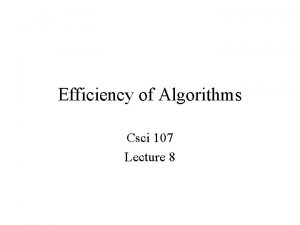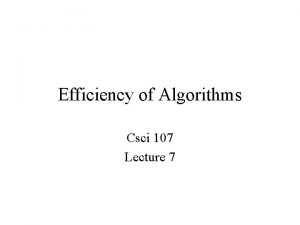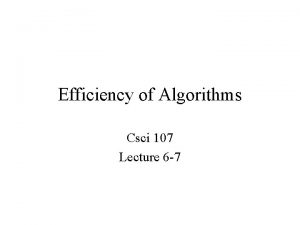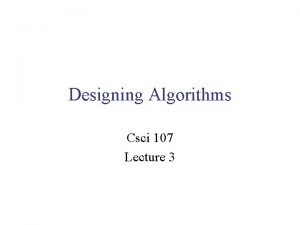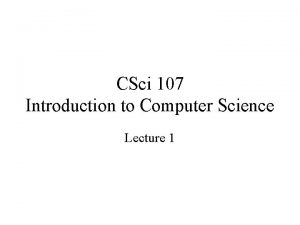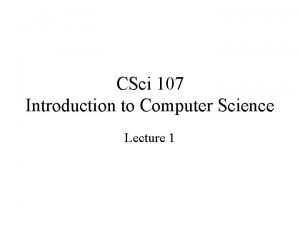Efficiency of Algorithms Csci 107 Lecture 7 Last















- Slides: 15

Efficiency of Algorithms Csci 107 Lecture 7

• Last time – Data cleanup algorithms and analysis – (1), (n 2) • Today – Binary search and analysis – (lg n) – Sorting • Selection sort

Searching • Problem: find a target in a list of values • Sequential search – Best-case : (1) comparison • target is found immediately – Worst-case: (n) comparisons • Target is not found – Average-case: (n) comparisons • Target is found in the middle • Can we do better? – No…unless we have the input list in sorted order

Searching a sorted list • Problem: find a target in a sorted list – How can we exploit that the list is sorted, and come up with an algorithm faster than sequential search in the worst case? – How do we search in a phone book? – Can we come up with an algorithm? • Check the middle value • If smaller than target, go right • Otherwise go left

Binary search • • Get values for list, A 1, A 2, …. An, n , target Set start =1, set end = n Set found = NO Repeat until ? ? – Set m = middle value between start and end – If target = m then • Print target found at position m • Set found = YES – Else if target < Am then end = m-1 Else start = m+1 • If found = NO then print “Not found” • End

Efficiency of binary search • What is the best case? • What is the worst case? – Initially the size of the list in n – After the first iteration through the repeat loop, if not found, then either start = m or end = m ==> size of the list on which we search is n/2 – Every time in the repeat loop the size of the list is halved: n, n/2, n/4, …. – How many times can a number be halved before it reaches 1?

Orders of magnitude • Order of magnitude ( lg n) – Worst-case efficiency of binary search: ( lg n) • Comparing order of magnitudes (1) << (lg n) << (n 2)

Sorting • Problem: sort a list of items into alphabetical or numerical order • Why sorting? – Sorting is ubiquitous (very common)!! – Examples: • Registrar: Sort students by name or by id or by department • Post Office: Sort mail by address • Bank: Sort transactions by time or customer name or accound number … • For simplicity, assume input is a list of n numbers • Ideas for sorting?

Selection Sort • Idea: grow a sorted subsection of the list from the back to the front 57216483| 5721643|8 521643|78 52134|678 … |1 2 3 4 5 6 7 8

Selection Sort • Pseudocode (at a high level of abstraction) – Get values for n and the list of n items – Set marker for the unsorted section at the end of the list – Repeat until unsorted section is empty • Select the largest number in the unsorted section of the list • Exchange this number with the last number in unsorted section of list • Move the marker of the unsorted section forward one position – End

Selection Sort • Level of abstraction – It is easier to start thinking of a problem at a high level of abstraction • Algorithms as building blocks – We can build an algorithm from “parts” consisting of previous algorithms – Selection sort: • Select largest number in the unsorted section of the list • We have seen an algorithm to do this last time • Exchange 2 values

Selection Sort Analysis • Iteration 1: – Find largest value in a list of n numbers : n-1 comparisons – Exchange values and move marker • Iteration 2: – Find largest value in a list of n-1 numbers: n-2 comparisons – Exchange values and move marker • Iteration 3: – Find largest value in a list of n-2 numbers: n-3 comparisons – Exchange values and move marker • … • Iteration n: – Find largest value in a list of 1 numbers: 0 comparisons – Exchange values and move marker Total: (n-1) + (n-2) + …. + 2 + 1

Selection Sort • Total work (nb of comparisons): – (n-1) + (n-2) + …. + 2 + 1 – This sum is equal to. 5 n 2 -. 5 n (proved by Gauss) => order of magnitude is ( ? ) • Questions – best-case, worst-case ? – we ignored constants, and counted only comparisons. . Does this make a difference? • Space efficiency – extra space ?

Selection Sort • In conclusion: Selection sort – Space efficiency: • No extra space used (except for a few variables) – Time efficiency • There is no best-case and worst-case • the amount of work is the same: (n 2) irrespective of the input • Other sorting algorithms? Can we find more efficient sorting algorithms?

This week… • Tuesday: Lab 4 • Exam 1 (Wednesday or Monday? ) – Material: Algorithms – Chapter 1, 2 & 3 from textbook • For next time – Binary search – Review chapter 1, 2 & 3 – Practice exam
 Complexity of algorithm
Complexity of algorithm The efficiency of algorithms
The efficiency of algorithms Efficiency of sorting algorithms
Efficiency of sorting algorithms Productively efficient vs allocatively efficient
Productively efficient vs allocatively efficient Allocative efficiency vs productive efficiency
Allocative efficiency vs productive efficiency Allocative efficiency and productive efficiency
Allocative efficiency and productive efficiency Analysis of algorithms lecture notes
Analysis of algorithms lecture notes Introduction to algorithms lecture notes
Introduction to algorithms lecture notes 01:640:244 lecture notes - lecture 15: plat, idah, farad
01:640:244 lecture notes - lecture 15: plat, idah, farad Randy pausch last lecture summary
Randy pausch last lecture summary 107 iq score
107 iq score Doc 107
Doc 107 Legge 107 del 2015
Legge 107 del 2015 107 1 fm
107 1 fm 12*107
12*107 107 nott terrace schenectady ny
107 nott terrace schenectady ny

